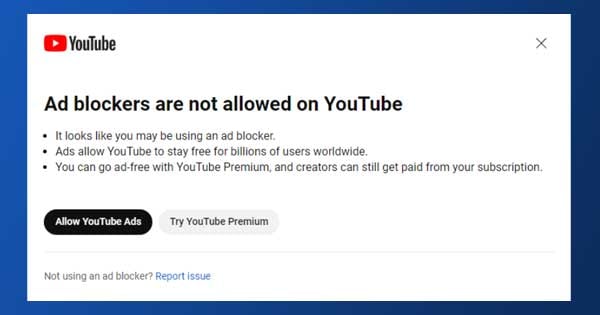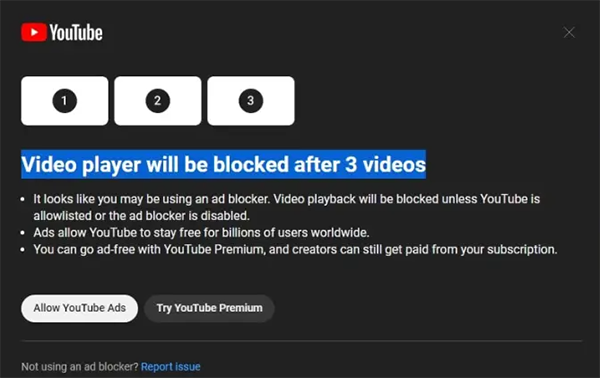Recently, YouTube viewers noticed something new. When visiting YouTube, a message popped up saying that "ad blockers weren't allowed on YouTube."

This message is part of an experiment that Google "is running globally that urges viewers with ad blockers enabled to allow ads on YouTube or try YouTube Premium." The experiment currently appears to a small percentage of users using ad-blocking software or browser extensions.
YouTube runs video ads, which the site says "allow YouTube to stay free for billions of users worldwide." Many consumers have adopted ad-blocking software so they can watch videos without interruptions. This results in lost ad revenues for YouTube.
Advertising is a primary source of revenue for publishers that supply digital content, news, or other information. Getting a premium subscription is an alternative for regular viewers who want to support a site. Revenues from content subscriptions offer a way for YouTube and other websites to provide ad-free content in a financially sustainable way.
This latest anti-adblock approach by YouTube engages with each adblock user via a direct message. The adblock user is notified that YouTube's "video player will be blocked after 3 videos." It continues with "It looks like you may be using an ad blocker. Video playback will be blocked unless YouTube is allowlisted or the ad blocker is disabled.”

Direct engagement with visitors, asking them to allowlist the site, or choosing to pay for an ad-free experience, has been leveraged by many large website publishers. Admiral has posted several head-to-head case studies on the efficacy of using engagement-based recovery vs. other methods, to provide a win-win option to balance visitor experience with the publisher's financial requirements.
UPDATE: Recently, YouTube has been testing the use of an ad countdown timer, demonstrating their belief in the value of modal visitor engagement for anti-adblocking.
Also, Wired reported on Nov 3, 2023, that record numbers of adblock uninstalls are being reported. "Munich-based Ghostery experienced three to five times the typical daily number of both uninstalls and installs throughout much of October," the article reports. And AdGuard saw uninstalls spike to 52,000 on a single day in October, over 6X of their normal daily uninstall rate.
Google has tried other experiments to balance visitor preference from supporting the site via ads-for-free-content, vs premium subscriptions. It has changed the placement of ads during videos. Experiments vary in size, demographics, and length of time, and may be affected by the cat-and-mouse attempts by adblock developers to circumvent the site's terms of service.
The YouTube blocking adblock message is trying to make viewers aware that free content isn't truly free. Someone has to produce it, pay for thousands of servers, build features, pay developers and support staff, etc.
YouTube's response gives users alternative ways to support content creators that they may not be aware of. They are helping to educate consumers that they have a choice of experiences, while still supporting the content creators and infrastructure that drew them there in the first place.
See also: How Much Publisher Revenue is Affected by Adblock?
Interested in learning more about engagement-based Full Stack Adblock Recovery?
Request a demo today.





